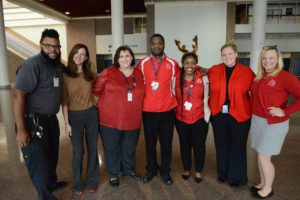Marcus “Chip” Murrell Named GM At Rocky Mount Event Center
Marcus “Chip” Murrell has been appointed general manager for the Rocky Mount (NC) Event Center, a Sports Facilities Management, LLC managed facility.
Murrell brings over 15 years of experience in the event industry to Rocky Mount, with his most recent duties as an operations director for the Columbia Metropolitan Convention Center in Columbia,  S.C. and the James L. Knight Center in Miami, Fla. Murrell’s responsibilities included leading the day-to-day back of house venue operations, leading his events team in the planning and implementation of all events, creating and successfully meeting annual budgets, maintaining inventory, and overseeing all service management agreements with outside vendors. As general manager for the Rocky Mount Event Center, Murrell will be responsible for managing all aspects of the pre-opening and operations of the facility scheduled to open fall 2018.
S.C. and the James L. Knight Center in Miami, Fla. Murrell’s responsibilities included leading the day-to-day back of house venue operations, leading his events team in the planning and implementation of all events, creating and successfully meeting annual budgets, maintaining inventory, and overseeing all service management agreements with outside vendors. As general manager for the Rocky Mount Event Center, Murrell will be responsible for managing all aspects of the pre-opening and operations of the facility scheduled to open fall 2018.
Murrell is a graduate of Winston Salem State University with a bachelor’s degree in Sports Management: Management and Administration. He is also a graduate of the IAVM Venue Management School and is currently an active member of IAVM and the Event Service Professionals Association (ESPA). In 2015, Murrell earned the Employee of the Year Award with the Midlands Authority for Conventions, Sports and Tourism.
Murrell began his duties on November 23.
New Orleans Ernest N. Morial Convention Center Employees Deliver Holiday Cheer To Families At The Ronald McDonald House Of New Orleans
Santa’s elves brought plenty of smiles to small faces as they delivered a hefty sack of toys to The Ronald McDonald House of New Orleans. New Orleans Ernest N. Morial Convention Center employees donated money via payroll deductions to raise funds to buy toys and supplies for the young patients who are spending their Christmas in a hospital setting as they battle various illnesses, as well as toys for their siblings, and gift cards and toiletry packs for the parents. The group also purchased items for the Ronald McDonald House, such as snacks, sheet sets, pillows, and flashlights.
Convention Center employees Kelli Zohar-Davis, Erin Oubre, Clair Lorell, Megan Clay, and Mildred Simon used their personal PTO hours to shop for toys at various local stores on Friday, December  15. The following week, on Tuesday, December 18, employees Nicole Newton, Maurice Jackson, Erik Gonzalez, Kelli Zohar-Davis, Cassie Jones, Megan Clay, Matthew Fryou, and AJ McCorkle distributed the toys and gifts to the families who reside at the Ronald McDonald House during treatment. Centerplate, the Convention Center’s exclusive food and beverage provider, generously donated 60 boxed lunches containing sandwiches, chips and fruit, plus cookies for a decorating activity.
15. The following week, on Tuesday, December 18, employees Nicole Newton, Maurice Jackson, Erik Gonzalez, Kelli Zohar-Davis, Cassie Jones, Megan Clay, Matthew Fryou, and AJ McCorkle distributed the toys and gifts to the families who reside at the Ronald McDonald House during treatment. Centerplate, the Convention Center’s exclusive food and beverage provider, generously donated 60 boxed lunches containing sandwiches, chips and fruit, plus cookies for a decorating activity.
“We are so grateful to the Convention Center employees who donated, shopped for, and delivered gifts and meals to the families staying in the House. It’s heartwarming to know that people care and took the time to make Christmas special for everyone,” said Brooke Stewart, Programs and Volunteer Coordinator Ronald McDonald House Charities of South Louisiana.
The Convention Center’s staff chose The Ronald McDonald House of New Orleans because of the organization’s commitment to improving the quality of life for families of seriously ill children.
The mission of the Ronald McDonald House Charities of South Louisiana is to provide a “home-away-from-home” to families of seriously ill children and to provide programs that give comfort, compassion, and care to children and their families. Parents with critically ill children are invited to bring their immediate family to stay in the Ronald McDonald House, free of charge, while their sick child receives treatment. The house provides a safe, homey place to stay, laundry facilities, and meals/snacks for the residents so that families don’t have to incur additional expenses and be separated during an already stressful time.
Kobe’s Retirement Ceremony Yields Record Sales At STAPLES Center’s Team LA Store
AEG Merchandise reported its third largest day of sales in STAPLES Center history, grossing more than $820,000 during Lakers Legend Kobe Bryant’s jersey retirement earlier this week at STAPLES Center in downtown Los Angeles.
As L.A. LIVE erupted with nearly 10,000 fans throughout the day for “Kobeland,” a free amusement-park style street fair prior to the Lakers vs. Golden State Warriors game, during which Bryant’s  No. 8 and No. 24 Lakers jerseys became the historic franchise’s 11th and 12th numbers to be retired and permanently displayed in the rafters of STAPLES Center, AEG’s three brick and mortar merchandise locations in Southern California collectively sold more than $670,000 in product.
No. 8 and No. 24 Lakers jerseys became the historic franchise’s 11th and 12th numbers to be retired and permanently displayed in the rafters of STAPLES Center, AEG’s three brick and mortar merchandise locations in Southern California collectively sold more than $670,000 in product.
“Having witnessed Kobe Bryant’s entire Lakers career, it was no surprise how many fans would want to acquire a piece of memorabilia to celebrate and remember one of the most remarkable careers in NBA history,” said Lee Zeidman, President, STAPLES Center and L.A. LIVE. “Kobe’s impact on the NBA, Los Angeles Lakers and fans everywhere may never be duplicated and it has certainly been our privilege to share so many great moments with him and his fans including last night’s celebration.”
Throughout the day AEG’s Team LA Store at STAPLES Center sold more than $600,000 with an additional $147,000 in online sales, while the New Era D Lab at L.A. LIVE sold nearly $40,000 in specially designed New Era caps and merchandise while the Los Angeles Lakers Team Shop, owned and operated by AEG, saw more than $20,000 in sales, generating $824,000 in sales.
“Through our understanding of Kobe Bryant’s influence on the Lakers organization, the City of Los Angeles and fans around the world, AEG teamed up with New Era, Nike, Kobe Inc. and Highland Mint to provide fans with high quality and collectible merchandise for this momentous occasion,” said Sean Ryan, vice president of merchandise, AEG. “Monday’s day-long tribute and overall phenomenal sales of the specially created items truly speak to the iconic legacy of Kobe Bryant.”
Industry Veteran Eric Granger Joins AEG Facilities As KFC Yum! Center General Manager
Eric Granger, an industry veteran with more than 20 years in the live entertainment, sports and facilities management industries, has been named general manager of KFC Yum! Center in Louisville, Kentucky. The announcement was made by Bob Newman, President of AEG Facilities, operators of the arena.
“We are thrilled to have Eric join the AEG Facilities and KFC Yum! Center team in Louisville,” Newman said. “Eric brings a great depth of knowledge and industry experience and will play a key  role in the continued success and stellar reputation of one of the region’s premier and busiest destinations for sports and entertainment.”
role in the continued success and stellar reputation of one of the region’s premier and busiest destinations for sports and entertainment.”
As general manager, Granger will be responsible for the management of all of the arena’s business operations, the creation of new events and the development of new revenue opportunities for the seven-year-old, 22,000-seat sports and entertainment arena which serves as the home of the University of Louisville men’s and women’s basketball programs. Granger will also oversee numerous proprietary initiatives of AEG Facilities including AEG S.A.F.E., AEG 1Source, AEG 1EARTH, AEG 1Force, AEG Encore and AEG Energy Services, in addition to working closely with AEG Global Partnerships and other divisions of the company.
“KFC Yum! Center is pleased to welcome Eric Granger and his family to Kentucky,” said Scott C. Cox, Chairman, Louisville Arena Authority. “Eric’s experience and talent will help maintain the arena’s reputation as one of the finest venues in the world.”
Granger assumes the role last held by Dennis Petrullo, who resigned earlier in the month.
Prior to joining AEG Facilities and KFC Yum! Center, Granger spent seven years serving as the vice president and general manager for Memphis, Tennessee’s 18,119-seat FedEx Forum, home to NBA’s Memphis Grizzlies and University of Memphis Tigers, in addition to serving as general manager of the Nationwide Arena in Columbus, Ohio, home of the NHL Blue Jackets.
“I am looking forward to working with the great group of professionals in Louisville with AEG Facilities and the Louisville Arena Authority,” Granger said. “KFC Yum! Center is an incredible facility.”
A graduate of University of South Alabama, Granger will assume his new role on January 1, 2018.
Happy Holidays from IAVM
 As another year comes to a close, The IAVM staff would like to thank you for being an invaluable part of the IAVM family. 2017 proved to be an amazing year for the association, and we look forward to serving you in 2018 and beyond.
As another year comes to a close, The IAVM staff would like to thank you for being an invaluable part of the IAVM family. 2017 proved to be an amazing year for the association, and we look forward to serving you in 2018 and beyond.
May your holiday be filled with laughter, joy, and prosperity throughout the New Year!
Do you want to receive a Front Row News weekly digest?
Categories
- Allied (861)
- Architecture (147)
- Arenas (747)
- Career (897)
- Convention Centers (895)
- Education (623)
- Events (1,544)
- Food & Beverage (193)
- Foundation (113)
- Guest Experience (1,496)
- Industry News (2,270)
- Leadership (1,888)
- Marketing (150)
- Membership (2,000)
- Music (213)
- Performing Arts Centers (454)
- Professional Development (409)
- Research (127)
- Safety & Security (442)
- Sports (763)
- Stadiums (608)
- Student (159)
- Technology (516)
- Ticketing (92)
- Touring (82)
- Trends (364)
- Uncategorized (743)
- Universities (218)
- Video (25)
- Young Professional (198)
Twitter Feed
- Twitter feed loading
Recent Posts
- Venuworks and ATG Entertainment Selected to Manage Fresno Convention and Entertainment Center
- Seattle Convention Center Announces Strategic Leadership Appointment and Growth Initiatives for 2026
- Peggy Daidakis Humbly Made Convention Center History
- Welcome to Our Newest Members
- New Member Benefit! IAVM Partners with Advantage Training to Elevate Staff Readiness and Guest Experience
Categories
- Allied
- Architecture
- Arenas
- Career
- Convention Centers
- Education
- Events
- Food & Beverage
- Foundation
- Guest Experience
- Industry News
- Leadership
- Marketing
- Membership
- Music
- Performing Arts Centers
- Professional Development
- Research
- Safety & Security
- Sports
- Stadiums
- Student
- Technology
- Ticketing
- Touring
- Trends
- Uncategorized
- Universities
- Video
- Young Professional
Archives
- December 2025
- November 2025
- October 2025
- September 2025
- August 2025
- July 2025
- June 2025
- May 2025
- April 2025
- March 2025
- February 2025
- January 2025
- December 2024
- November 2024
- October 2024
- September 2024
- August 2024
- July 2024
- June 2024
- May 2024
- April 2024
- March 2024
- February 2024
- January 2024
- December 2023
- November 2023
- October 2023
- September 2023
- August 2023
- July 2023
- June 2023
- May 2023
- April 2023
- March 2023
- February 2023
- January 2023
- December 2022
- November 2022
- October 2022
- September 2022
- August 2022
- July 2022
- June 2022
- May 2022
- April 2022
- March 2022
- February 2022
- January 2022
- December 2021
- November 2021
- October 2021
- September 2021
- August 2021
- July 2021
- June 2021
- May 2021
- April 2021
- March 2021
- February 2021
- January 2021
- December 2020
- November 2020
- October 2020
- September 2020
- August 2020
- July 2020
- June 2020
- May 2020
- April 2020
- March 2020
- February 2020
- January 2020
- December 2019
- November 2019
- October 2019
- September 2019
- August 2019
- July 2019
- June 2019
- May 2019
- April 2019
- March 2019
- February 2019
- January 2019
- December 2018
- November 2018
- October 2018
- September 2018
- August 2018
- July 2018
- June 2018
- May 2018
- April 2018
- March 2018
- February 2018
- January 2018
- December 2017
- November 2017
- October 2017
- September 2017
- August 2017
- July 2017
- June 2017
- May 2017
- April 2017
- March 2017
- February 2017
- January 2017
- December 2016
- November 2016
- October 2016
- September 2016
- August 2016
- July 2016
- June 2016
- May 2016
- April 2016
- March 2016
- February 2016
- January 2016
- December 2015
- November 2015
- October 2015
- September 2015
- August 2015
- July 2015
- June 2015
- May 2015
- April 2015
- March 2015
- February 2015
- January 2015
- December 2014
- November 2014
- October 2014
- September 2014
- August 2014
- July 2014
- June 2014
- May 2014
- April 2014
- March 2014
- February 2014
- January 2014
- December 2013
- November 2013
- October 2013
- September 2013
- August 2013
- July 2013
- June 2013
- May 2013
- April 2013
- March 2013
- February 2013
- January 2013
- May 2012
- March 2012
- December 2011
- November 2011
- October 2011
Recent Comments
- Frank Bradshaw, Ph.D., CVE on John Meyer, CVE, a Tireless Advocate of Certification for Venue Professionals, Has Died
- Neil Sulkes on Hilary Hartung, Friend to Many in Venue Marketing, Has Left Us
- Jason Parker, CVE on The Devastation of Hurricane Helene and How We Can Support One Another
- Larry Perkins on Touhey Testifies Against Speculative Ticketing Before Congressional Subcommittee
- Peter Secord on Major Players for Planned Elkhart Amphitheater Were in the Mix at VenueConnect
